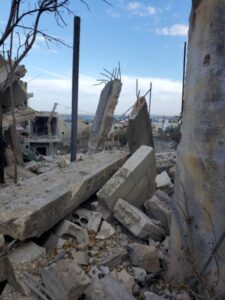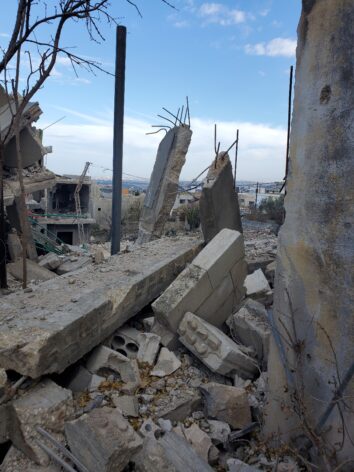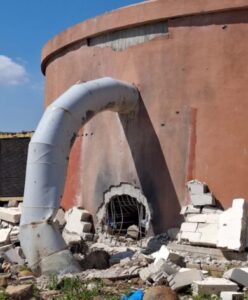
Armed Conflicts, Civil Society, Development & Aid, Editors’ Choice, Featured, Headlines, Health, Human Rights, Humanitarian Emergencies, Middle East & North Africa, Sustainable Development Goals, TerraViva United Nations
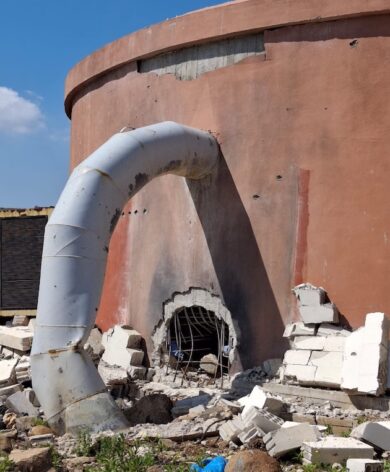
Damage to the water tank at the Maisat water pumping station.
Credit: WaSH Sector Lebanon
– Just under a year into a fragile ceasefire, 150,000 people in southern Lebanon continue to deal with the potentially lethal aftermath of Israeli bombing, highlighting the devastating long-term effects of conflict.
A report published late last month (AUG) by Action Against Hunger, Insecurity Insight, and Oxfam said that at least 150,000 people remain without running water across the south of Lebanon after Israeli attacks had damaged and destroyed swathes of water sanitation and hygiene (WASH) facilities since the beginning of the conflict in Lebanon.
The report, When Bombs Turn the Taps Off: The Impact of Conflict on Water Infrastructure in Lebanon, laid bare both the immediate and long-term effects of repeated attacks on Lebanese water infrastructure between October 2023 and April 2025.
It said that more than 30 villages were without any connection to running water, leading to long-term disruption to supplies of fresh water, fueling dependence on water trucking that many people cannot afford and, according to the World Bank, losses estimated at USD171 million across the water, wastewater and irrigation sectors.
A severe rainfall shortage in recent months has exacerbated the problem, increasing risks of outbreaks of waterborne diseases as vulnerable communities are forced to resort to utilizing unsafe or contaminated water sources for their daily needs.
But groups behind the report warn that without mitigating action, the situation could become even worse.
“We can see there is the potential for some severe long-term repercussions of these attacks. There are 150,000 people without running water at the moment, but that number could rise in the future,” Suzanne Takkenberg, Action Against Hunger’s country director, told IPS.
Among the groups’ biggest concerns is the effect of the destruction on local agriculture.
In villages near the southern Lebanese border, farmers’ irrigation networks have been destroyed, cutting off vital water supplies to farms. Trucked-in water supplies have not been sufficient to replace this and allow them to irrigate land or give drinking water to their livestock, farmers say.
Meanwhile, farmers have also been unable to access their land due to security concerns—a November ceasefire between Israel and Hezbollah has held only partly, with violations reported regularly—compounding problems with food production.
“One of our major worries is the mid- to long-term effects of the difficulties for farmers to irrigate their land,” explained Takkenberg.
“They have been struggling to irrigate their land since October 2023, due to security concerns hindering access to their land, as well as water problems. We have seen as a consequence of these attacks that food prices have increased and food productivity has decreased.”
Another concern is the growing reliance on trucked-in water for communities.
“Worryingly, people are becoming dependent on using water that is trucked in. This is sometimes ten times more expensive than using water from a public network, and the checks on that water are not the same as those carried out on public water supply networks,” said Takkenberg.
“Water quality after any kind of conflict is a concern and we are definitely worried about it in southern Lebanon after these attacks,” she added.
Illness and disease related to water quality and shortages are major concerns.
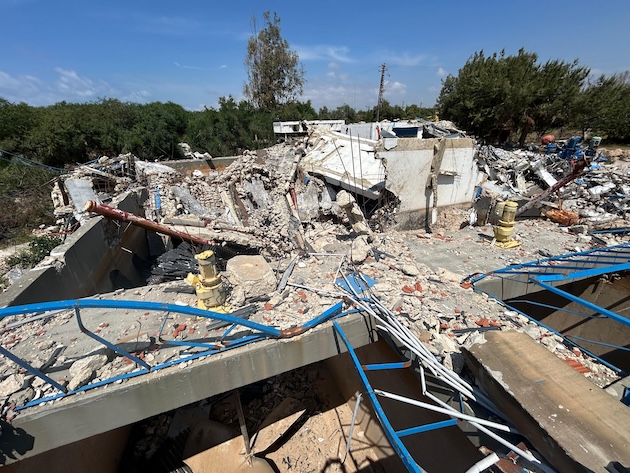
A destroyed water pumping station in Tyre, Lebanon, following an airstrike in November 2024.
Credit: Insecurity Insight
While the report states that waterborne and water-related illnesses were not reported by people interviewed, some highlighted the limited resources available for testing water quality and possible contamination. There are also worries that water may have been contaminated by white phosphorus, the use of these munitions in Lebanon having been verified by Human Rights Watch.
Meanwhile, there are further concerns that residents may resort to using unsafe water sources due to limited supplies, a situation exacerbated by low rainfall and water shortages at critical reservoirs.
Local officials interviewed for the report also highlighted damage to sewerage networks in some areas. This, combined with the known large-scale damage to water infrastructure and the possibility that damaged sewerage infrastructure has contaminated water sources, ramps up the potential of negative long-term effects on health if the water supply crisis is not adequately addressed, the report states.
It also points to evidence from Ethiopia, Ukraine and the Middle East, demonstrating clear links between damage to water and sanitation infrastructure during conflict and adverse public health outcomes.
“People are cutting back on their water use, which can have an effect on health and hygiene and raises disease risk—cholera is already epidemic in Lebanon and this situation could exacerbate that. Other diseases could also be spread. We have already seen cases of watery diarrhea, which is bad not just in itself, but also because in children it can cause problems with malnutrition as their bodies struggle to absorb nutrients,” Takkenberg said.
But while the potential long-term impact of the damage and destruction to water infrastructure is severe, early action could mitigate the worst possible outcomes, experts say.
“There is an urgent need to repair systems and while this is ongoing, to track water into the area. The consequences of water system destruction are rarely immediate. Most often, the impacts accumulate over time. It is the combination of destroyed infrastructure with the failure to repair it, insufficient water trucking, or lack of access to trucked-in water that eventually produces devastating outcomes for individuals and communities,” Christina Wille, Director of Insecurity Insight, told IPS.
“This is why the destruction of infrastructure demands close attention: if not effectively mitigated, cascading consequences are inevitable. People may be forced to leave, adding to the numbers of displaced populations, or they may fall ill. Yet there is also an opportunity—by addressing damaged infrastructure early—to prevent the worst outcomes of displacement and disease and to save lives,” she added.
But while repairing and rebuilding water infrastructure is essential to preventing the most severe long-term impacts on local communities, implementing it is a different matter.
Authorities have managed to carry out some limited repairs to some networks, but issues around the continued presence of Israeli forces and concerns about ongoing conflict violence have prevented wider-scale or more extensive reconstruction. Finances for repairs are also under strain amid the socio-economic crisis the country has faced since 2019.
“Disease outbreaks are very predictable and the cost of not dealing with them is much worse than dealing with them now. The health ministry has been good in warning [of potential health risks] but there is a limit to what the government can do with the resources that are available after years of economic crisis. It is a very difficult situation,” said Takkenberg.
The report ends with a call for, among others, all parties to the conflict to strictly comply with the ceasefire agreement and adhere to international humanitarian law (IHL) and ensure the protection of civilians, health workers, and essential infrastructure.
It urges humanitarian programmers and donors to support the rehabilitation and operationalization of conflict-affected water infrastructure and ensure temporary access to safe water and basic sanitation services through the provision of water trucking, emergency water points, and safe wastewater discharge.
The report also says UN member states should push for the establishment of independent, impartial, and transparent investigations into all allegations of IHL violations.
Satellite imagery shown in the report indicates that in at least several incidents the damaged or destroyed facilities were located in large open areas without clearly identifiable military targets, suggesting that in some cases they may have been specifically and deliberately targeted.
The authors of the report point out that under IHL, parties to a conflict must always distinguish between lawful military targets and civilians and civilian objects and that deliberately targeting civilians and civilian objects is prohibited and amounts to a war crime. The various kinds of water infrastructure are protected as civilian objects under IHL and must never be attacked.
“Determining whether each incident deliberately targeted water infrastructure would require access to confidential military decisions, which is not available, as well as information on whether any military objectives were present at the time of the attacks. Our data is limited to the observable effects on the ground following the attacks. Nevertheless, the scale and nature of the observed damage raise serious questions regarding compliance with international humanitarian law, which governs the conduct of hostilities,” said Wille.
While it may not be possible to determine whether the attacks were deliberate, their impact is clear and highlights the need to look at not just the direct but also indirect effects of conflict, said Wille.
“Conflict deaths are not only direct (caused by weapons) but also indirect, when the destruction of systems produces cumulative and deadly consequences. The more complex and interconnected our societies become, particularly in securing food and water, the more vulnerable they are to such systemic shocks. At the same time, it becomes harder to trace devastating outcomes back to a single act of destruction.
“This is why we must learn to examine conflicts through the lens of systems and interconnectivity and to apply this knowledge to our legal analysis of the conduct of warfare,” she said.
“The public needs to ask more direct questions about the conduct of warfare and how the principles of distinction, proportionality, and precaution are being applied. We need a broader debate on how these principles should be interpreted in today’s conflicts. Modern societies rely on highly interconnected and complex infrastructure to secure basic needs such as food and water, while warfare is increasingly conducted remotely through advanced technologies. In this context, what counts as proportional? And what kinds of precautions are necessary in today’s world?” she added.
IPS UN Bureau Report

